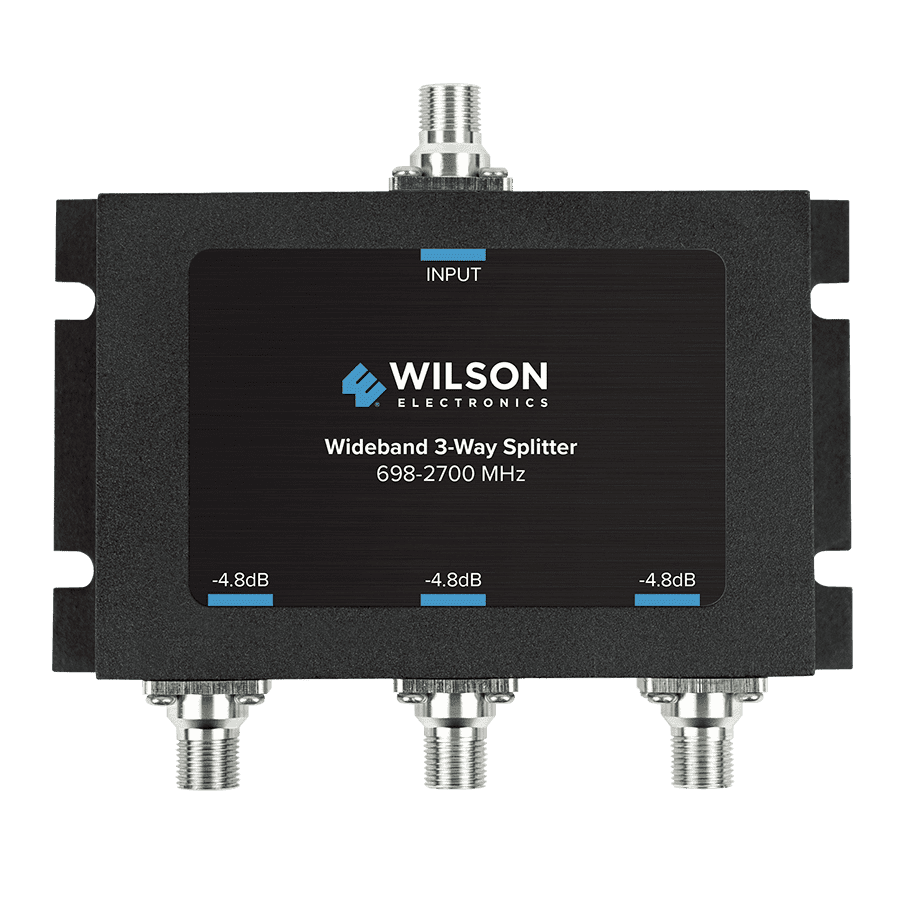Wilson 850035 Three-Way Wide-Band Splitter with F-Female Connectors
Your Order Includes:
- 90-Day Returns
- Lifetime Tech Support
- 2-Year Warranty
- Lowest Price Guarantee
How to Choose the Right Antennas for Your Booster
Outside Antennas:
- Yagi Directional Antenna: This antenna is more powerful because it focuses on sending and receiving signals in one direction. It works best when there are no major obstacles blocking its path to the cell tower. It's not ideal for areas with large obstructions like hills or buildings.
- Omni Antenna: This antenna sends and receives in all directions, so it's better for hilly areas or if you need to support multiple carriers with towers in different directions. It doesn’t need to be aimed, but it also isn’t as strong as the Yagi antenna.
- High Gain LPDA Antenna: Perfect for areas with very weak signals, this antenna significantly boosts signal strength. It needs a clear line of sight to the cell tower and requires a sturdy mount because of its size.
- High Gain Omni Antenna: Similar to the standard omni, this antenna receives signal from all directions but delivers significantly higher gain across all supported bands. It’s a much stronger option when you want more inside coverage than a standard omni will provide, especially in areas with weaker outside signal.
Inside Antennas:
- Panel Antenna: Can be placed on walls or ceilings and directs the signal towards a specific area. This antenna is great for homes and tall ceilings in buildings.
- Standard Dome Antenna: Designed to be mounted on the ceiling, this antenna spreads the signal evenly throughout the area. It's best suited for drop ceilings or spaces where cables can be run above the ceiling.
- Ultra-Thin Dome Antenna: This slim antenna also mounts to the ceiling, but is much is less noticeable. It's much stronger than a standard dome antenna, making it a great choice for places where both looks and signal strength are important.
Tips for Choosing:
- Choose Omni Antennas for general coverage with no aiming required.
- Choose Directional Antennas (Yagi or LPDA) when you can point directly at a cell tower and need stronger signal and more inside coverage.
- Interior Size Considerations: One antenna per 750-1,500 sq ft in homes, or 1,500-2,500 sq ft in open spaces like offices and warehouses.
Product Overview
Product Overview
The Wilson Three-Way 700-2500 MHz 75 Ohm Splitter, model 850035, is engineered for signal distribution systems, enabling the division of a single input signal into three outputs. It is perfectly suited for cellular mobile communication, functioning within the frequency range of 698-2700 MHz.
Key Features:
- Frequency Compatibility: Operates across frequencies from 698 to 2700 MHz, accommodating a wide array of cellular signals.
- Low Loss: Boasts a low insertion loss of 0.5 dB and a splitter loss of 4.5 dB, ensuring minimal signal reduction.
- Connectivity: Comes with F-Female connectors for secure coaxial cable connections.
- High Isolation: Delivers high isolation with low ripple, reducing interference between outputs.
- Build Quality: Utilizes a microstrip structure for reliable and efficient signal splitting.
- Power Handling: Capable of managing up to 50 watts of power, catering to a range of signal amplification requirements.
Specifications:
- VSWR: ≤2.3:1, indicating efficient signal transmission.
- Isolation: ≥20 dB, ensuring minimal cross-talk between outputs.
- Dimensions: 4.0 x 4.7 x 0.8 inches (LxWxD) with a weight of 10.88 oz, providing a compact solution for signal distribution.
- Operating Temperatures: Rated for use in environments ranging from -40 to 140°F, guaranteeing performance under various conditions.
This splitter is an essential tool for enhancing signal distribution systems, offering a balance of high performance, reliability, and durability. Suitable for use in residential, commercial, or industrial settings, the Wilson Three-Way Splitter ensures efficient signal management with minimum loss.
Specifications
Specifications
-
SKU850035
-
UPC811815028987
-
ConditionNew
-
Impedance
-
ConnectorF-Female
-
dB Loss



